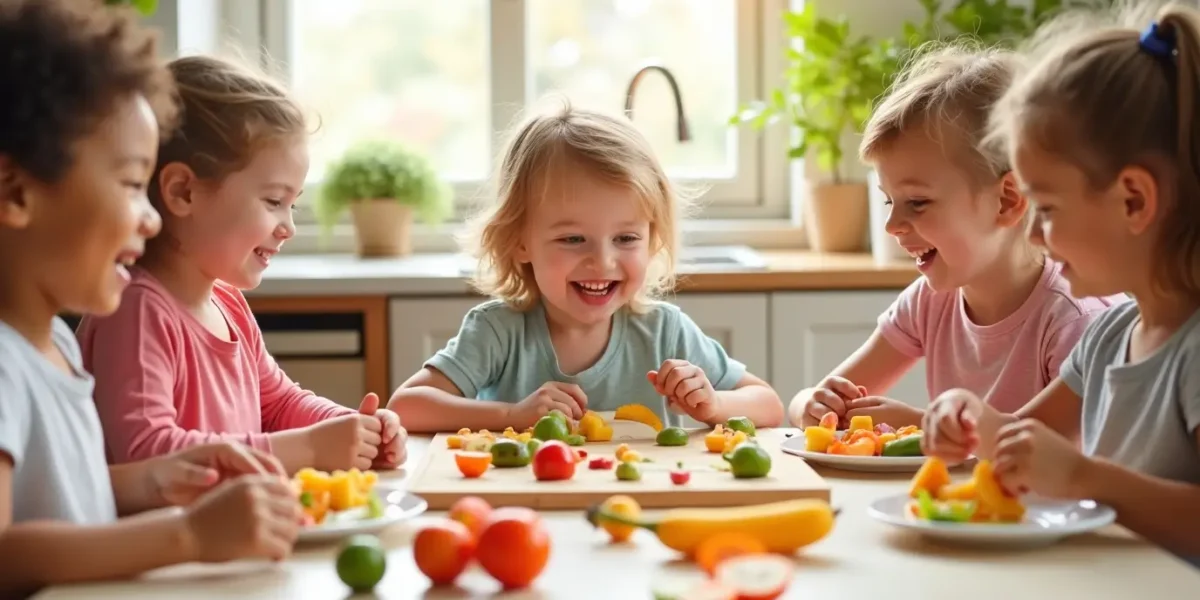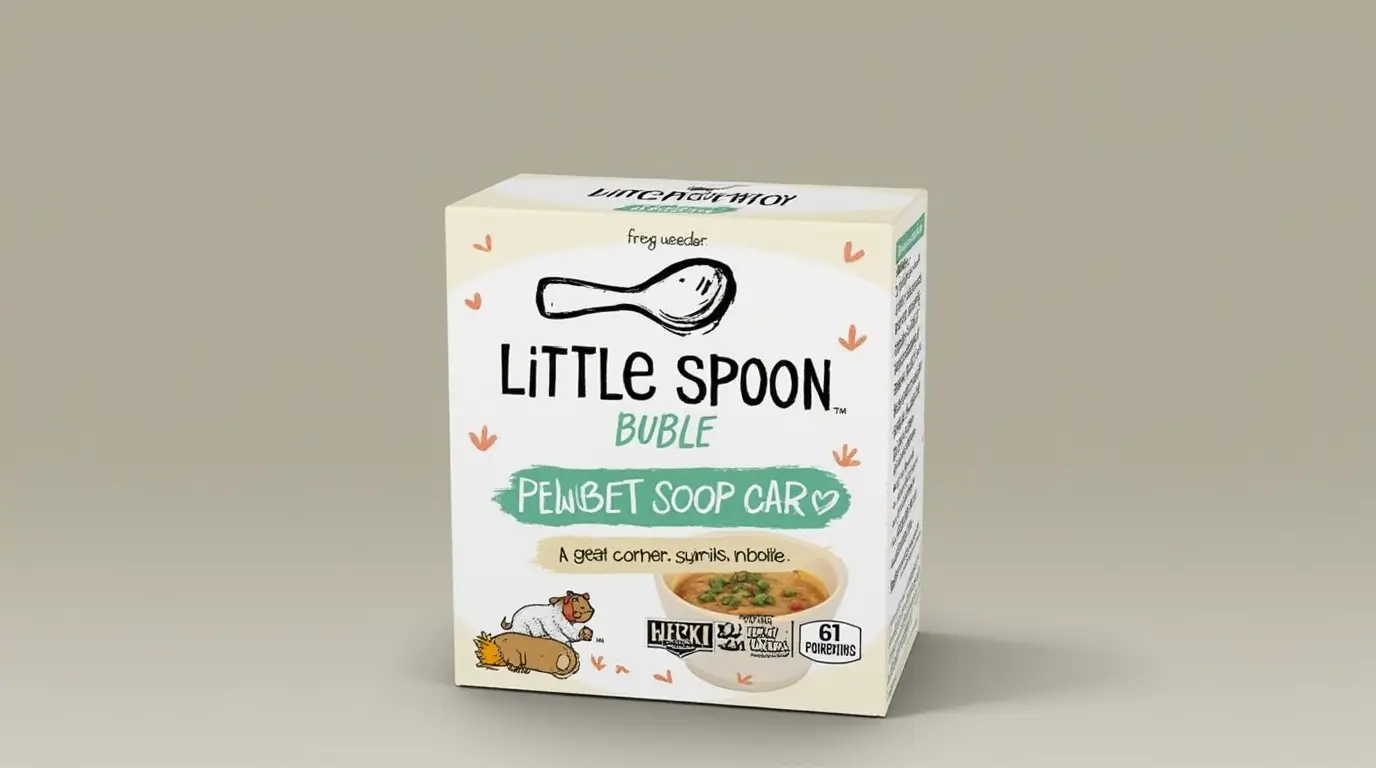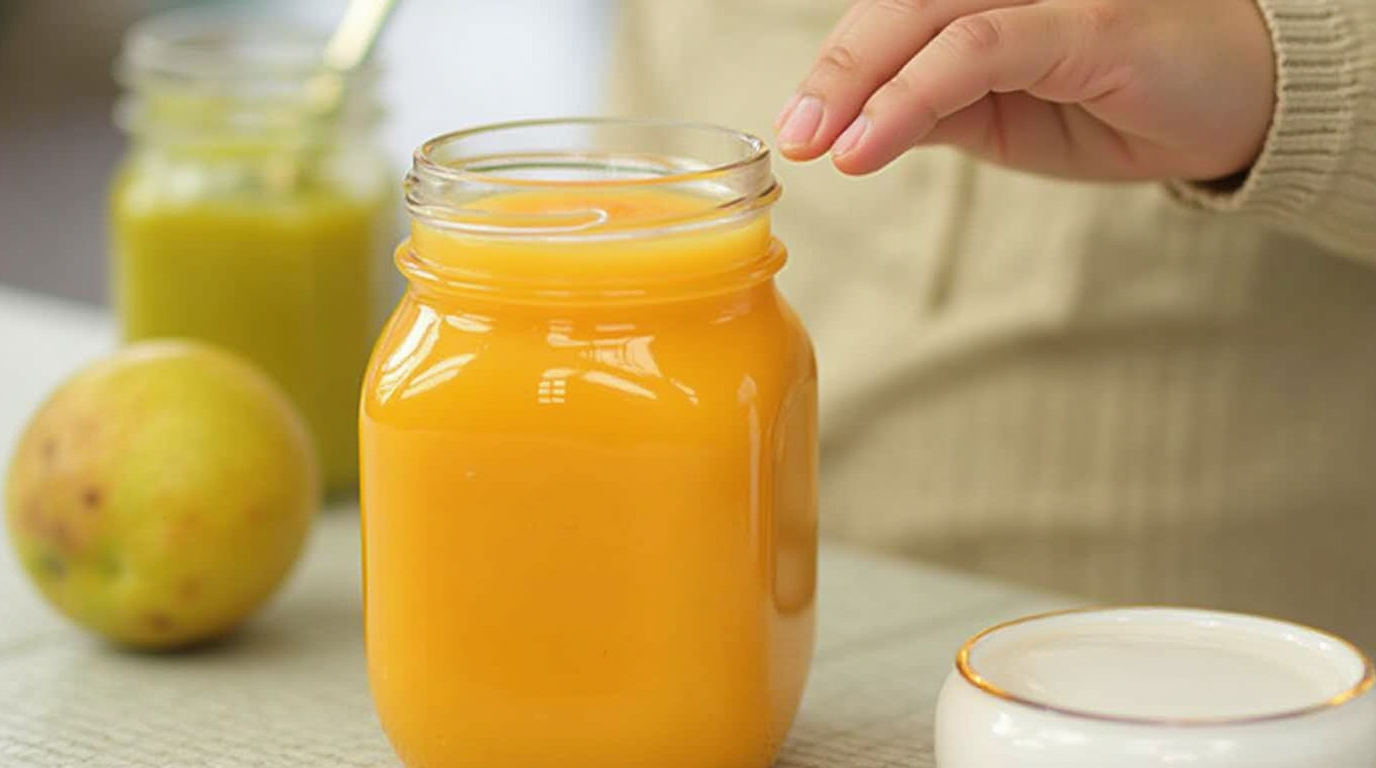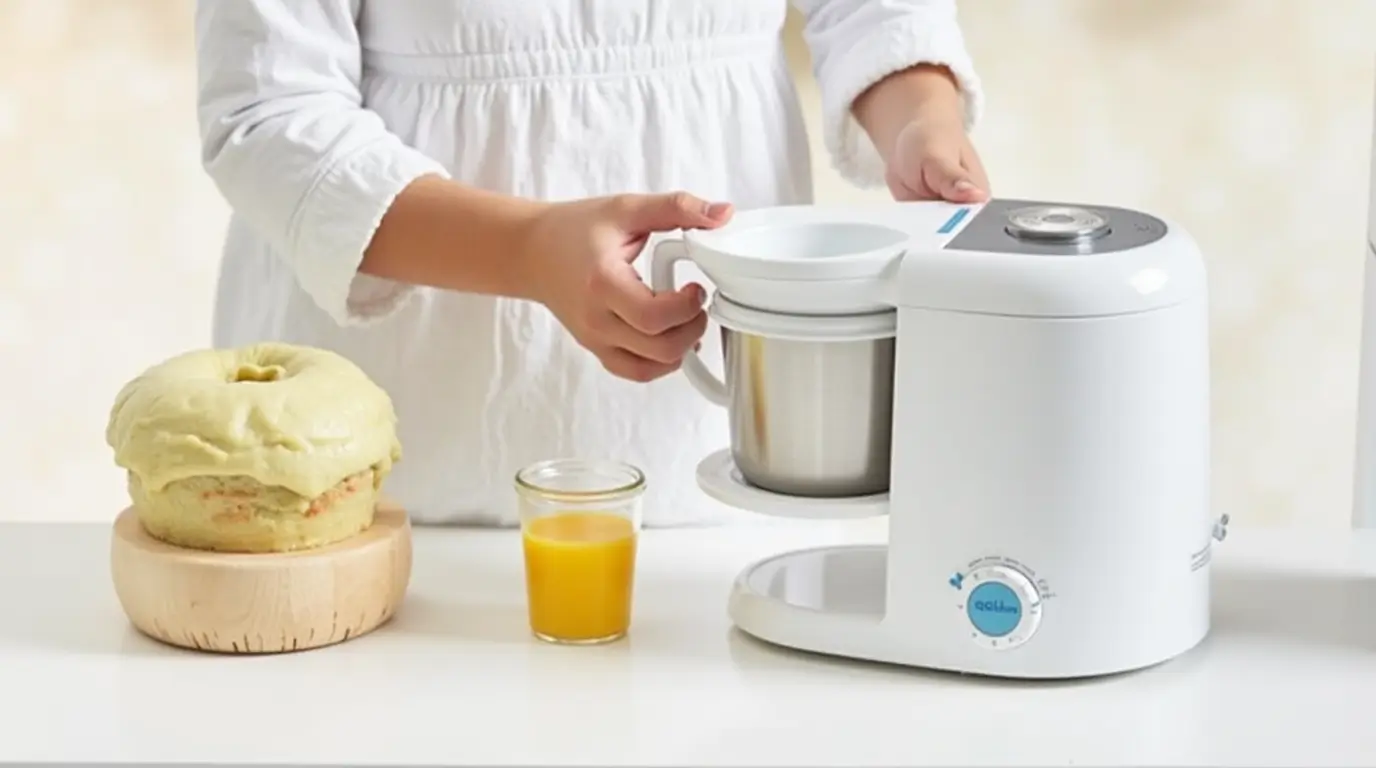Table of Contents
Introduction
Feeding children can often feel like a battle—but what if it could be playful, fun, and educational? Kids Food Games transform mealtime into an opportunity to engage young minds, build healthy eating habits, and reduce stress around food. In this article, you’ll find plenty of ideas, strategies, and practical guidance to turn food into a playful adventure. We’ll cover:
- Why play-based feeding works
- Game ideas by age group
- Tips for success
- Addressing picky eaters
- Sample game plans and weekly schedules
- Two tables: one comparing game types, another offering a 7-day game plan
- A short conclusion and call to action
Why Use Games with Food?
Benefits of food games
- Reduced mealtime stress: Turning eating into a game reduces pressure; children feel more in control and less resistant.
- Greater willingness to try new foods: When a food is part of a fun challenge, children often surprise us by tasting things they’d normally reject.
- Language, motor, and cognitive development: Counting peas, sorting fruits, or naming colors all build crucial skills.
- Stronger parent-child connection: Shared play strengthens trust and positivity around meals.
- Positive associations with healthy food: Using games helps children associate fruits, vegetables, and wholesome ingredients with fun, not frustration.
Kids Food Games : Psychological principles at work
- Intrinsic motivation: Children play because it’s fun; if tasting or chewing is part of the “fun,” compliance is higher.
- Scaffolding: Tailor difficulty to their age; gradually increase complexity.
- Positive reinforcement: Praise efforts, not just success, which builds confidence.
- Modeling & social learning: Joining in the game yourself shows them food is safe and enjoyable.
Organizing Your Approach
Before launching into game ideas, it helps to have a simple framework:
- Choose the goal – e.g. increase fruit variety, practice chewing, reduce mealtime resistance.
- Select age-appropriate games – use the tables below.
- Gather supplies – safe utensils, colorful mats, etc.
- Introduce gently – explain the game, demonstrate, and invite participation.
- Be flexible – if a game fails one day, try again later or adapt.
- Track lightly – a simple sticker chart or journal helps you see progress.
Game Ideas by Age Group
Here are creative, scalable games you can try, organized by age:
Kids Food Games : Ages 6–12 months
At this stage, many babies are still exploring textures and tastes. Games should be very simple, sensory-based, and safe.
- Texture matching: Offer two small trays—one smooth (e.g. pureed carrot) and one slightly lumpy (e.g. mashed banana). Let baby dip fingers or spoon into both, and “guess” which is which.
- Peek-a-food: Hide small soft pieces (steamed carrot, banana slice) under cups. Show, swap cups, then uncover: a fun variant of peek-a-boo.
- Sound & crunch: If baby is ready for soft finger food (e.g. soft steamed vegetable sticks), let them hear the crunch. You say “crunch?” before they bite.
- Color splash: Use two purees of different colors (pea & carrot). On a mat, drop a tiny dollop of each, let them explore mixing. Talk about “green, orange, what happens when they meet?”
- Tiny spoons relay: Using two spoons, place a dot of puree at start, and “relay” from spoon to spoon toward baby’s plate. You can “race” (slowly) and narrate.
Kids Food Games : Ages 1–2 years
Toddlers love interactive, tangible games. This is a great age to build food curiosity and practice self-feeding.
- Fruit & veggie lotto
Create simple laminated cards showing fruits and vegetables. Draw a card, show the real food, ask the child to “find the match” on their plate or in a basket. - Taste detective
Blindfold (or have eyes closed), then offer tiny spoonfuls of three surprising but safe foods (e.g. apple, sweet potato, mango). Let them sniff, taste, guess. - Color sorting challenge
Provide small pieces of fruit or vegetable (e.g. red pepper, yellow pepper, cucumber). Give three bowls labeled by color, and ask the child to sort. - Food dominoes
Make domino-like cards where one half shows a fruit, the other half another fruit (or color). Kids match like in standard domino rules. - Counting bites game
Use colored toothpicks or safe small sticks. After each bite, the child moves one stick from one cup to another. See how many bites they eat.
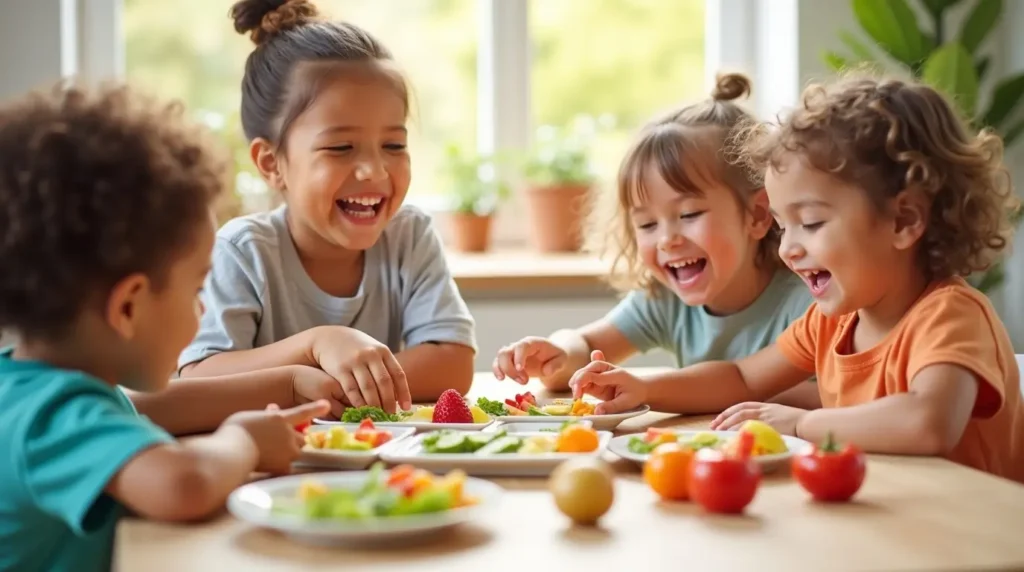
Kids Food Games : Ages 3–5 years
Preschoolers can handle more rules, counting, strategy, and stories.
- “Rainbow plate” challenge
The goal is to eat as many colors of food as possible in one meal. Use a chart and award a “mini badge” for each color eaten. - Food bingo
Create your bingo grid with pictures of food items. As you call them out (“banana, carrot, kiwi…”), child covers them. If they’ve eaten that item that day or will try it now, they cover. - Plate puzzle
Use a divided plate shaped like puzzle pieces; when they complete each piece by eating it, it “locks in.” - Opposite me game
You say, “I’ll eat red, you eat green,” or “I take big bite, you take small bite.” Switch after a few rounds. - Story-food path
Draw a simple path on paper; each step has a small food icon. You move a small figurine along the path, and at each step the child tastes or eats that food. Reach the “castle” when done.
Kids Food Games : Ages 6–8+ years
At this stage, children can enjoy more strategy, competition, and creativity.
- Recipe relay
In small teams, children collect ingredients (from pre-prepared safe piles) and assemble a snack or small dish. Time it or make it collaborative. - Mystery ingredient challenge
Let the child pick one secret safe ingredient (from a selected list) to add to a smoothie or salad. They then present the flavor and guess what the secret is. - Cook & score
You and the child each “judge” the dish on criteria (taste, color, presentation). Use star stickers. - Food treasure hunt
Hide clues around the kitchen or dining room; each clue leads to a food item to taste or use. - Nutrition quiz race
Create cards with “true/false” nutrition statements. Split the family into teams. Draw a card, read statement, teams race to buzzer or ring if true or false. Correct answers move you forward on a board.
Game Types & Benefits
Below is a table summarizing types of food games and the benefits they bring. You may adapt it for your own needs.
| Game Type / Format | Age Range | Key Benefits | Typical Materials |
|---|---|---|---|
| Texture matching & peek | 6–12 months | Sensory exposure, curiosity | Purees, cups, spoons |
| Taste detective / blindfold | 1–2 years | Encourages tasting, builds vocabulary | Small spoons, blindfold, food sample |
| Color sorting / lotto | 1–3 years | Sorting skills, color recognition | Bowls, cut vegetables/fruits, cards |
| Rainbow plate challenge | 3–5 years | Variety exposure, motivation | Colored food, chart, stickers |
| Recipe relay / cook & score | 6–8+ years | Collaboration, planning, creativity | Ingredients, cooking tools, timer |
Sample 7-Day Game Plan
Here is a weekly schedule of food games you can try. Feel free to swap days to suit your routine or child’s mood.
| Day | Meal Time | Game Idea | Goal / Focus |
|---|---|---|---|
| Monday | Lunch | Color sorting challenge | Encourage different colored veggies |
| Tuesday | Snack | Taste detective | Introduce a new fruit or veggie |
| Wednesday | Dinner | Rainbow plate challenge | Eat as many colored foods as possible |
| Thursday | Breakfast | Texture matching | Encourage exploration of textures |
| Friday | Lunch | Food bingo | Familiarize with fun food vocabulary |
| Saturday | Snack + Dessert | Recipe relay / mini cooking | Build ownership and excitement |
| Sunday | Dinner | Story-food path | Make tasting part of a narrative |
You can repeat this weekly or adapt with new games and themes.
Kids Food Games : Tips & Best Practices for Success
- Keep portions tiny at first
Don’t overwhelm — a pea or two is enough. - Set the scene
Use a colorful mat or fun tray, name the game, introduce rules. - Be patient
Some days a game won’t fire. Try again later or tweak. - Offer choices
“Do you want to play color sort or food domino?” gives control. - Play with them
Children love when adults join in, even imperfectly. - Don’t force finish
If they don’t want the next bite, that’s okay — the game is the goal. - Rotate and refresh
Change up foods, game rules, or props to keep novelty. - Document wins
A sticker, tally, or photo helps you see progress — and motivates both sides. - Link to meal planning
Use ingredients you already plan to serve to minimize waste. - Safety first
Always supervise, avoid choking hazards, and adapt to developmental stage.
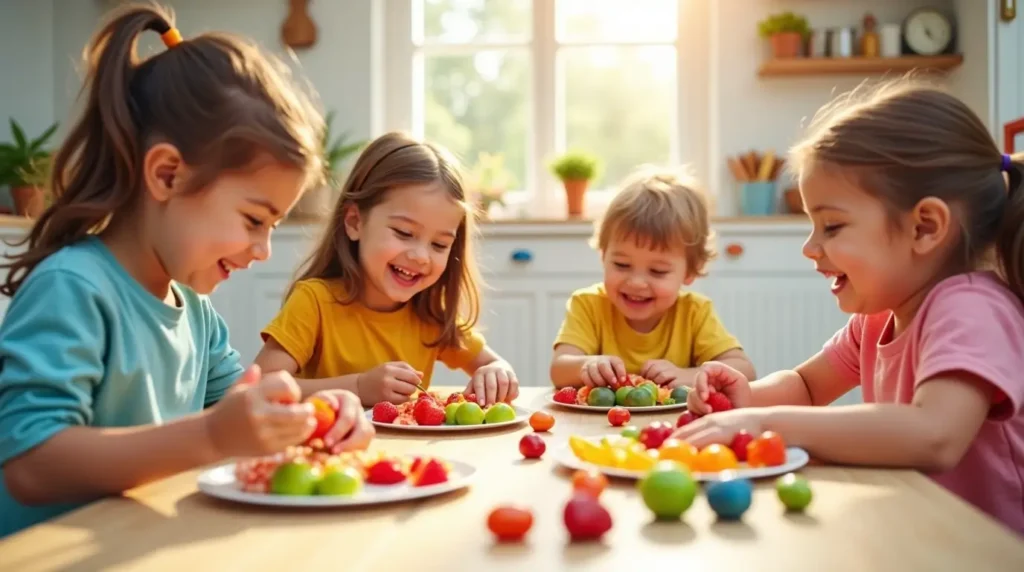
Addressing Picky Eaters & Challenges
Even with the best “Kids Food Games”, resistance may persist. Here are strategies:
- Start with favorites
If they adore banana, include banana in early games to build trust. - Mix known + unknown
Pair a familiar food with a new one in a game. - Use peer influence
Let siblings or playdates join, letting children imitate. - Narrative & storytelling
Use a plot (dragons, astronauts) where tasting food is part of the mission. - Offer “no thank you” bite
In game rules, allow one “no” bite choice without pressure. - Desensitization
Let them touch or play with the food without needing to eat it first. - Repeat exposure
It may take 8–15 exposures before a child accepts a new food (research supports repeated exposure). - Stay calm & positive
Avoid coercion; battle = resistant response. - Limit distractions
Turn off screens, minimize toys (except the game material) to keep focus. - Be consistent
Even when tired, offering a brief game keeps momentum.
Kids Food Games : Integrating with Your Online Resources
To deepen value and interlink your site, you may embed internal links at strategic spots. For instance:
- After describing fruit games or ideas, you could insert a synthèse to your “Glow Recipe Fruit Babies” page (highlighting fruit-based baby snacks or recipes).
- When discussing utensils, preparation, or blending, you may embed a synthèse to your “Baby Food Processor” page, guiding parents to suitable tools or tutorials.
These synthèse links not only enrich the content but also keep readers on your site for more value.
Expanded Examples & Detailed Walk-throughs
Let me illustrate two sample game sessions in more detail:
Example A: “Mystery Ingredient Challenge” (for ages 6–8+)
Objective: To familiarize children with new flavors and encourage open-minded tasting.
Setup:
- Prepare 3–4 small ingredients (e.g. berries, spinach, basil, sweet potato) that blend safely.
- Place each in a covered bowl.
- Provide a small bowl of neutral base (e.g. plain yogurt or very mild puree).
Rules:
- Let child pick one bowl secretly (without seeing inside).
- Blend (or mix) the mystery into a scoop of base.
- Present it and let child smell, taste, and guess the secret.
- Reveal answer and talk about flavor, texture, and how they’d use it again.
Extensions:
- Give them points or a “detective badge” for correct guesses.
- Let them become the “chef” next time, inventing a mystery ingredient for you to guess.
Why it works:
- It gamifies tasting rather than pushing consumption.
- It gives them control: they guess, they discover.
- You build vocabulary: “herby,” “earthy,” “sweet,” “savory.”
Example B: “Color Sorting Challenge” (for ages 1–3)
Objective: To build awareness of colors and vegetables/fruits, while giving them agency at mealtime.
Setup:
- Chop soft fruits and veggies into very bite-sized pieces (e.g. red tomato, yellow pepper, green cucumber).
- Provide three small bowls labeled “red,” “yellow,” “green.”
- Place the pieces unsorted in a central tray or basket.
Rules:
- Invite child: “Let’s sort by color before we eat!”
- They pick a piece, name the color, and drop it in the matching bowl.
- After sorting, you blend or plate them in a “rainbow snack.”
Variation:
- Instead of color, sort by shape (circle, square, stick).
- Or by size (big vs small) for older toddlers.
Why it works:
- Sorting is inherently playful and gives them agency.
- They talk about color and decision-making.
- After sorting, they feel ownership over the sorted food, increasing willingness to taste.
Kids Food Games : Troubleshooting & FAQs
– What if the child refuses even to play?
Offer a “mini version” (just one or two pieces) or revert to a low-stakes game like touching or naming colors. Try again later.
– Is this time-consuming?
It might feel slower initially, but as you reuse props or simplify, it becomes quite efficient.
– What if leftovers accumulate?
Use leftover game bits in soups, smoothies, or freeze small portions.
– Are there allergies/cultural constraints?
Always adapt to dietary restrictions. Replace foods that aren’t allowed. Focus on colors, shapes, textures that fit your context.
– What if siblings or distractions intervene?
Embrace them: let them join, compete, or help set up. A bit of friendly rivalry can boost engagement.
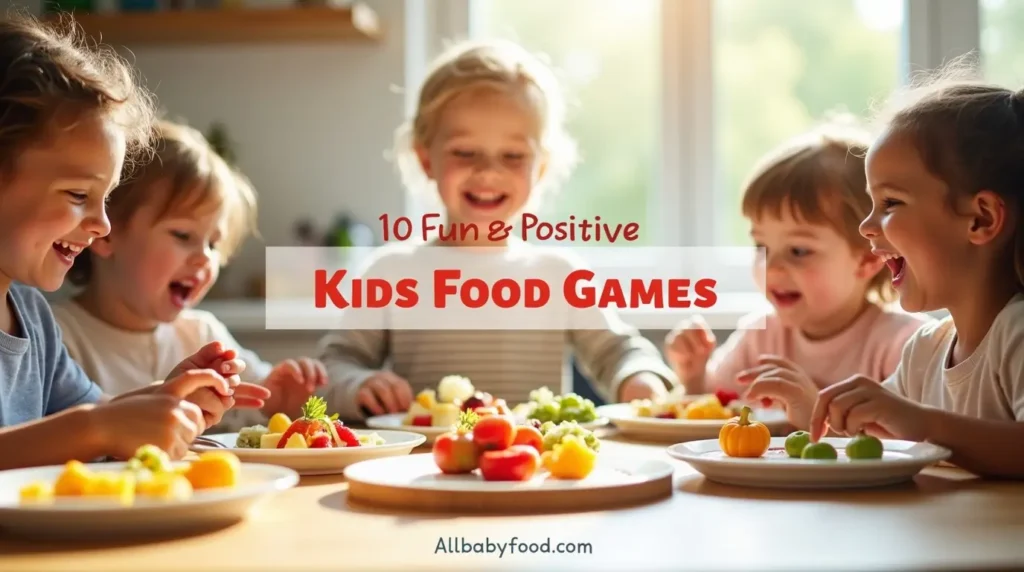
Kids Food Games : Monitoring Progress & Adjusting
To ensure your Kids Food Games approach is effective, you might:
- Keep a simple journal noting which games the child liked, which foods they tried, and any obstacles.
- After 3–4 weeks, review: did they try more variety? Did mealtimes seem less tense?
- Rotate out games that no longer excite, and introduce fresh ones.
- Consult your “Baby Food Processor” resource (via the synthèse link) when you need tips on blending or preparing new textures.
- Use your “Glow Recipe Fruit Babies” resource (via the synthèse link) to inspire fresh fruit-based ideas, smoothie pops, or baby fruit snacks.
Kids Food Games : Conclusion & Next Steps
Kids don’t just eat—they explore. By transforming mealtime into play through Kids Food Games, you give children agency, reduce resistance, and plant seeds for a lifetime of healthier relationships with food.
To get started:
- Pick one game that feels easy (color sort, taste detective, or rainbow plate).
- Gather minimal props (cut fruit, small bowls, cards).
- Invite your child gently, model it, and keep expectations light.
- After a week, reflect on what worked, adjust, and plan new games.
- Use your site’s resources (like Glow Recipe Fruit Babies and your Baby Food Processor pages) to deepen ideas, recipes, and preparation support.
